Improved forage as supplemental feed source and its utilization system in Yem special Woreda of Central Ethiopia
Abstract
This study was conducted to assess the improved forage production and Utilization. For this study, three kebeles were selected purposively based on their livestock potential and 160 households were selected from selected kebeles randomly. The major feed resource in the study area was crop residue and pasture land grazing. Desho and elephant grass were the dominant forage species adopted in the area. Feed shortage was the primary problem or livestock production. Majority of the households (66%) were in the active productive age (31-45) about 60% of household heads were literate (primary school and above).The mean cultivated land holding was 0.25 ha in study area. Crop production is the main source of cash income (1st rank) followed by cattle (2nd rank) and sheep (3rd rank) production. Almost all householders in study area have experience to produce improved forage specifically elephant grasses and desho which are most common in the study area. The major constraints in the study area that related to livestock production is disease (1st rank) followed by feed shortage (2nd rank) and water shortage (3rd rank), poor breed performance. Among major feed sources identified, grazing, crop residue and desho grass were given 1st, 2nd and 3rd rank in the study area respectively.
Introduction
Livestock population of south nation national people region state (SNNPR) estimated to 12,404,963 cattle, 4,735,604 sheep, 4,819,573 goats, 292,496 horses 305,089 donkey, 7,0365 mules, and 7,347,205 poetry (CSA, 2020). Despite the large livestock population in the country with high potential for meat and milk production, the contribution of the sector is well below its biological potential due to various reasons. Feed Shortage and disease, fewer effects in introducing the appropriate improved livestock technologies, cross breeds, improved feeds management practices feed scarcity is indicated as a factor responsible for lower production, reproductive and growth performance of animal especially during the dry season (Hurissa and Legesse, 2008).
During dry season, in adequacy of grazing resources result for animals not to be able to meet even their maintenance requirements and lose substantial amount of their weight. Livestock feed resources are classified as natural pasture, crop residue, improved pasture, forage, agro industrial by product and other by products like food and vegetable refusal, with the first two contribute the largest feed type (Mengistu, 2003). Animal depends mainly on natural pasture for their feed requirements. However, natural pastures which provide more than 90% are very poorly managed.
The important of natural pasture is gradually declining and expansion of crop production in to grazing lands also redistribution of common lands to the landless and land degradation (Berhanu et al., 2009). Though increased utilization of agro-industrial products has been reported, they are not available, affordable or feasible for most of the small holder farmers in Ethiopia. Hence, animals are allowed to graze natural pasture or crop stubbles around homestead supplemented with weed was the major feeding practice and it is now shifting to zero grazing because of continuing shrinkage of grazing.
Thus, there is no doubt that evaluating the current potential and identification of challenges that threatening this potential is mandatory in order to keep and exploit the current potential and tackle the threatening problems. Identification of feed resources and opportunities and constraints associated to livestock feeding are therefore, preconditions.
This study was, therefore, initiated to assess the feed resources utilization system and improved forage production status in the study area.
Material and Methods
Description of the study area
The study was conducted in Yem special woreda, located in the north-western apex of the Southern Nations, Nationalities and Peoples Regional State of Ethiopia. The administrative center of Yem special woreda (Saja city) is located at 247 km from Addis Ababa Southwest Ethiopia. Yem is bordered on the west and north by the Oromia Region, and separated from Gurage on the northeast and Hadiya on the east by the gibe River. Yem occupies a surface area of 724.5 km2. The woreda lies within elevations of 920–2939 meters above sea level (MASL) and has three agro climatic zones; namely, Dega (cool highlands) (18.4%), WeynaDega (tropical highlands) (57.6%) and Kolla (lowlands) (24.0%). It receives a mean annual rainfall of 900 – 2200 mm in a bimodal pattern, from mid-February to April, and June to September. The mean annual temperature is in the range of 12– 30°C. The topography of Yem district is characterized by rolling mountains, long gorges, steep slopes and flat to undulating plateaus. The physiographic features of the woreda are characterized by high peaks and mountains and partly by deep gorges of Gibe River to the east. The total human population of the woreda as per 2007 population census is estimated to be 80,647 of which 50.3% are male and 49.7% female (CSA, 2011) and the population density is 111.3 persons/km2. The major livestock production system in the woreda is cattle in Mixed crop-livestock farming comprising more than 43.7% (n = 107,201) of regional livestock population.
Data collection techniques
All relevant primary and secondary data source was employed for this study. Both qualitative and quantitative data from primary and secondary sources was used. The primary data was collected from sampled households, Woreda agricultural offices, from site development agents (DA) and others who have adequate information about the existing situation of the research area. Structured questionnaire which was filled by respondents, focus group discussion with farmer groups and an in depth interview was conducted to collect the primary data. On the other hand qualitative data type was collected through focus group discussion and informal discussions with administrators and personal observations. Secondary data was collected from records of the woreda agricultural offices, and related literature prepared by government and nongovernmental organization. Such data sources include journal, research works, articles, statistical report, and official world-wide web sites for literature review and information about the study area.
Key informant interview was carried out to collect required primary data that lead to discussion with concerned bodies to obtain information about the issue related to the study objectives and description of study area. The key informant of this particular study was livestock directorate experts and kebeles level extension agents. The interview was recorded by using checklist.
Sample size
According to the data obtained from the Yem special woreda agriculture and natural resource development office, there are 32 rural kebeles and 5 urban centers in the woreda. Two-stage sampling procedure was employed in this specific study. In the first stage, the 3 representative kebeles was selected purposively based on the livestock production potential. These selected kebeles were Daritegu, Ediya and Oyakepo. Secondly, within the 3 kebeles, 135 households were selected using random sampling methods.
Research design
The study applied cross sectional survey method that both qualitative and quantitative design was employed to address the proposed study objectives. Quantitative methods aim to classify features, count them, and create statistical methods and explain observations, interview and use of questionnaires. Qualitative methods aim for a complete, detailed description of observations, including the context of events and circumstances. In order to achieve the objective of the research, considering the nature of the problem and the type of the assessment, this study was using both qualitative and quantitative research approaches.
Methods of data analysis
Data was analyzed with reference to the purpose or to the objective of the study, and was in referring to the research problem at hand or the hypothesis. The process of data analysis includes steps like categorization, coding, statistically adjusting the data and tabulation. Finally SPSS (Version 20.0) was used to analyze data and the results were presented in the form of tables and figures. Descriptive statistics was applied to describe the collected data using mean, standard deviation, percentages, and graphs.
Results and Discussion
Household characteristics
Information on family size, age and educational level of household’s were indicated in Table 1. Average family size of a household is (Medium family size (4-6)) 45. Male and female headed households were 80% and 20%, respectively. Majority of the households (66%) were in the active productive age of 31-45 and 60% of household heads were literate (primary school and above). Average family size of a household was 6.56.
Average family size of a household (Medium family size of 4-6) in the current study is in agreement with previous assessment report (7.3) (Biruk et al., 2014) conducted in the same location from different agro ecology and in Anelemo district (Salo et al., 2017). In most rural part of Ethiopian, family members are the main source of household labor. Hence, large family size could be taken as an opportunity with regard to accomplishing laborious farm activities. However, large family size could have negative impact on the livelihood of the family if economic activities and income sources are limited (Abba, 2010). The presence of large family size might be attributed to labor demanding agricultural activities in the area (Yadessa, 2015) and/or lack of awareness on proper family planning methods.
Education on the other hand plays great role in transferring technology and in initiating farmers’ willingness to adopt different technologies. Accordingly, in this study, about 60% of household heads were literate (primary school and above) that can be considered as an opportunity to easily disseminate different technologies through strengthened trainings. Majority of the household head being in the range of active working age groups is also a big opportunity to undertake multiple tasks.
Table 1: Age, Sex, Educational level and Family size of a household
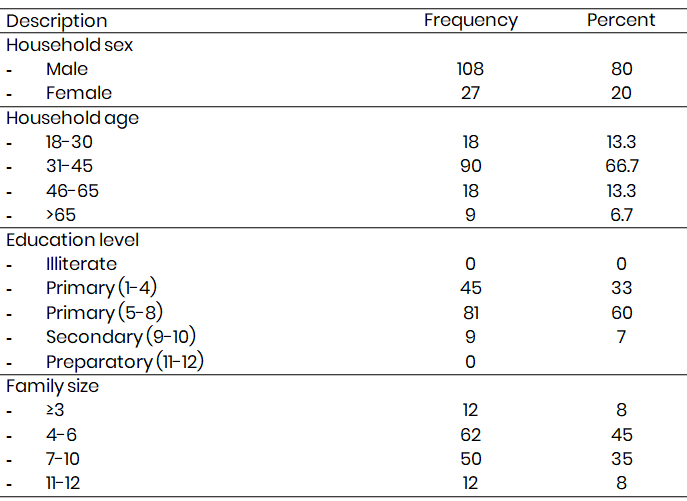
Farming characteristics and land holding
Farming activities and land holding was presented in Table 2. Major farming activities in the study area were cultivation/cropping and rearing livestock (86%) followed by both Farming and labor (24%). The mean land holding of the area was 0.25 ha.
The total average land holding per household in the study areas in the current study were similar with reports for average land holding (0.52 ha) in Anelemo district (Salo et al., 2017) and for Doyogena district (0.5-1 ha) (Mekonnen et al., 2014). However, the value in the current study was lower than a report for Burie district (Yenesew, 2013), and 2.98 reported for enset based farming system in Enorworeda of Gurage zone (Adem, 2024). Family size could have an impact on the livelihood of the farmers. The situation further will exacerbate the problem unless development options are arranged for landless groups, and intensive and wise land resource use practices are applied. There was no significant variation in land holdings among farmers.
Major occupation in the district being farming followed by both farming and petty trading sites indicated that farming (both crop and livestock), is the main means of living in the study area.
Table 2: Major occupation and land holdings
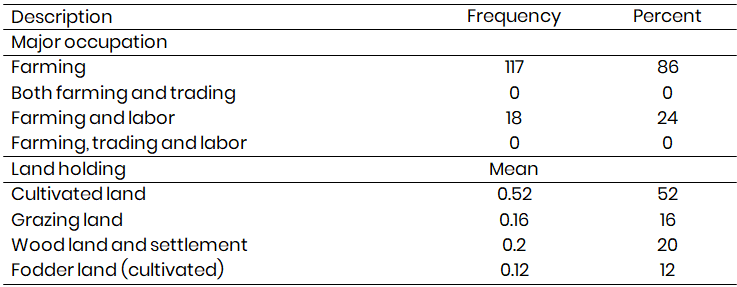
The contribution of agricultural activities to the household income
Income contributions of different agricultural activities are indicated in Table 3. Farmers in the area had different sources of income, where crop production is the main source of cash income (1st rank) followed by cattle (2nd rank) and sheep (3rd rank) production. Forages feed was also to lesser extents (5th rank) serve as income source.
This result is in consistent with report for Lemu district of Hadiya zone. The lower contribution of small ruminant compared to cattle was related with small number small ruminant holding of the area.
Table 3: The contribution of different agricultural activities to the household income

Livestock production challenges
Challenges for livestock production in the study area were shown in Table 4. The major constraints in the study area that related to livestock production was disease (1st rank) followed by feed shortage (2nd rank) and shortage of water (3rd rank), poor breed performance and others.
These problems were in line with reports for Horro and Guduru districts (Gurmessa, 2015). Moreover, local breeds are resistant to disease and can perform better under limited feed availability and easy management condition (Getahun, 2008).
Table 4: Major livestock production challenges

Livestock feed shortage and coping mechanisms
Specific feed shortage, time of shortage and coping mechanisms are presented in Figure 1. About 96% households in the study areas were responded as they are suffering from feed shortage. Majority (80%) of farmers faced the challenge during dry season starting from December to May and farmers were responded as they use different coping mechanisms to alleviate the problem of feed shortage. Purchasing grass and concentrate, and feeding non-conventional feed resources like kitchen wastes and enset leaf are most adopted coping mechanisms in the study site which is in line with reports for several highland parts of Ethiopia (Deribe, 2015).
The feed shortage problem observed during dry seasons in the study area was related with moisture stress that resulted in low herbage growth on existing grazing land as similar reports that supports these results are exists from different location of Ethiopia having similar agro ecology. Purchasing grasses which are serving as the main source of roughage during dry season (Salo et al., 2017), but low in their nutrient content (Deribe, 2015).
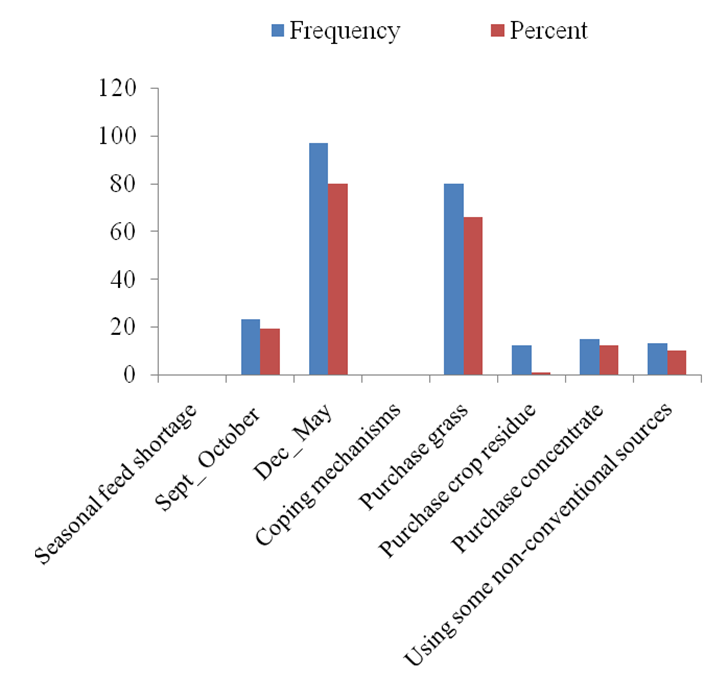
Fig. 1: Feed shortage problems and coping strategy % of respondent (N=135)
Livestock feed sources
The major feed resources used for cattle in the area are indicated in Table 5. Among major feed sources identified, grazing, crop residue and desho grass were given 1st, 2nd and 3rd rank in the study area respectively.
The results relating to feed resources show the dominancy of grazing, crop residue and local grass in the study area which is similar with reports for Anelemo district of Hadiya zone (Salo et al., 2017). Concentrate feed utilization in the study area was high during dry period with the objective of supplementing poor quality roughages that are available during dry season. As a result of grazing land shortage that resulted in fewer animals stocking rate, majority of farm households practice day time controlled/tethered grazing and night time feeding in individual.

Table 5: Major cattle feed sources in the district (N=135)
Seasonal livestock feed availability and utilization
The seasonal availability and utilization of existing feed resource are presented in Table 6. Crop residues, Grazing, Elephant grass and Desho grass were the major feed resources available and utilized in the study areas. Among these, Crop residues, Grazing aftermath Elephant grass, Local grass and Desho grass were the major feeds and frequently utilized in dry seasons. On the other hand, Grazing on pasture, Elephant grass, Local grass (cut and carry system) and Desho grass were the major feeds and frequently utilized in wet seasons. Improved forages were mostly utilized in both dry and wet season of the year as supplement.
Table 6: Seasonal availability and utilization of feed resources (N=135)

Livestock feeding practice
Seasonal animal feeding practices identified are given on Fig. 2. Most of the farmers were practicing individual night time feeding and controlled grazing during day time. Free grazing feeding practice were the most commonly used in the study area.
Majority of the householders of the study area has experience to use several supplementary feeds like Atela’ (local brewery by products), wheat bran, and others (food grains, enset corm, food wastes, root crop tubers, sweet potato vine).
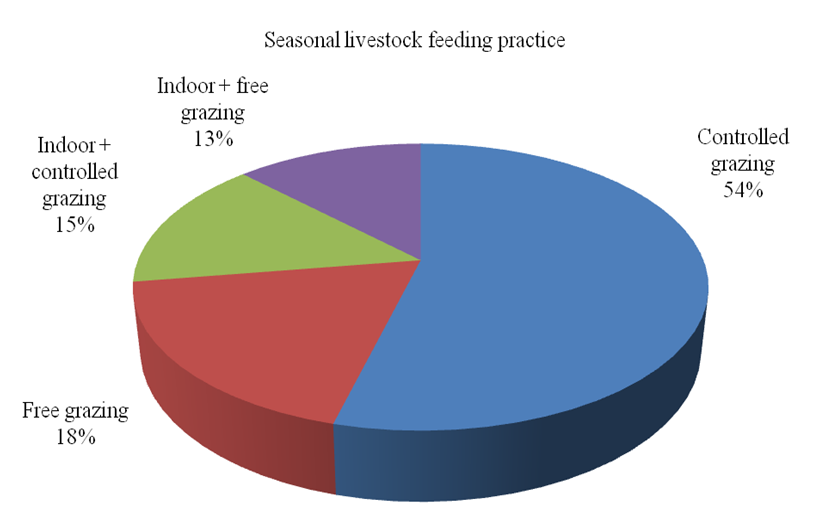
Fig. 2: Seasonal livestock feeding practice
Improved forage production
The major improved forage produced in the area is presented in Table 7. Almost all householders in study area (100%) have experience to produce improved forage specifically elephant grasses and desho which are most common in the study area. Satariya and Guatemala grasses are newly introduced forage species.
Improved forage production is believed to be remedies for overcoming feed shortage but is constrained by many challenges including small land holding, encroachment of food crop production, lack of forage seeds, and limited knowledge on forage species and their production systems. This situation was exacerbated by absence of improved forage seed provision and transfer system in the area. In contrary to this result, land was reported as primary constraint in Anelemo and Robi district (Salo et al., 2017) and (Yadessa, 2015).

Constraints for improved forage production
Major constraints that hampered improved forage productions are presented on Fig. 3. Majority of the householders responded that they have shortage of Land and Financial problem as primary constraints followed by lack of awareness; with shortage of land were highly prominent (93%) in the study area.
Lack of awareness on different improved forages and its production strategies together with the shortage of land and improved forage seeds had hindered the scaling up of improved forage technologies. Hence, this situation calls attention for application of different forage development strategies and introduction of legume forages that can be integrated with other cropping system.
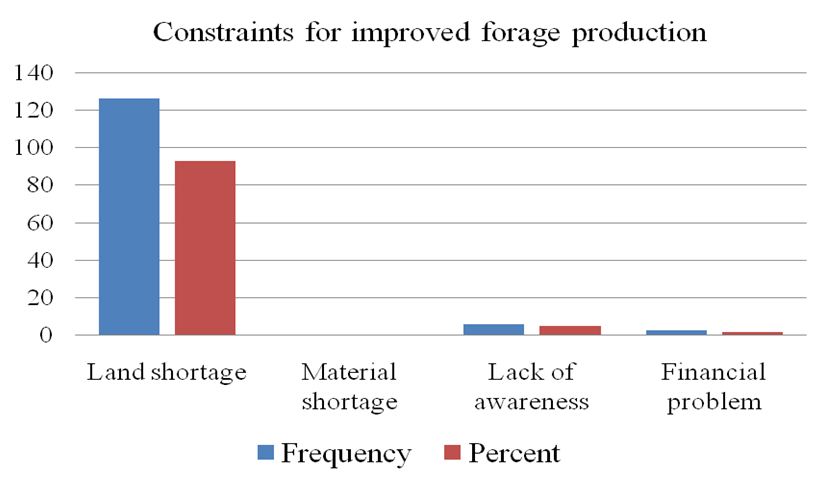
Fig. 3: Major constraints for improved forage production in the area (N=135)
Conclusion
The major feed resources in the area were natural pasture which is shrinking from time to time as a result of converting lands to food crop production. Besides, the quality of available feed from pasture land is not substantial to livestock need, because its quality and quantity was highly fluctuated to the season of the year. Hence feed shortage was recorded as primary constraints in the study area following seasonal fluctuation. Accordingly, feed shortage season started from end of December to May. The observed feed shortage was exacerbated by lack of supplementary feed like improved forage production in the area. As a result, purchased feeds and several locally available by products like enset leaf were used as a coping mechanism against feed shortage. Though it was not at adequate level, these were starting points for improved forage adoption in the area. So introducing of improved forage like desho grass, vetch, elephant grass, sesbania, and lecuceana were becoming as common practice in the study area. Farmers gave particular emphasis to lactating cows, pregnant cows, fattening cattle and calves in utilizing this improved forage. Shortage of land, lack of awareness and the increased piece of forage seed were the main constraints that hinder the adoption of improved forage.
Acknowledgements
First of all, I would like to express my sincere gratitude to Wolkite University for financial and overall supports for my whole works. I am also grateful to Mr. Mebrate Gebresilasie for his valuable support during data collection. Lastly, I would also like to extend my appreciation to all my friends from Department of Animal Science who have been supportive throughout and provided a stimulating environment for my work.
Conflicts of interests
Authors declare that there is no conflict of interest exists.
References
Abba, B. (2010). Livelihood strategies of small holders with particular focus on model farmers: the case of lemoworeda, Hadiya zone, SNNPR, Africa, (pp. 90).
Adem, K. (2024). Feed Resources for Livestock and Improved Forage Production Status in EnorWoreda, Gurage Zone of Ethiopia. American Journal of Life Sciences, 12(6), 104-112. https://doi.org/10.11648/j.ajls.20241206.11
Berhanu, G., Jaleta, M., & Hoekstra, D. (2009). Small holders, institutional services, and commercial transformation in Ethiopia. Agric. Econ., 40, 773–787. doi: 10.1111/j.1574-0862.2009.00414.x
Biruk, S., Yilma, T., Andualem, M., & Tilahun, B. (2014). Health Professionals’ Readiness to Implement Electronic Medical Record System at Three Hospitals in Ethiopia: A Cross Sectional Study. BMC Medical Informatics and Decision Making, 14, 115. https://doi.org/10.1186/s12911-014-0115-5
Central Statistical Authority. (2020). Agricultural sample survey. 338, Volume IV, CSA, Addis Ababa.
CSA. (2011). Agricultural sample survey 2010/11. Volume II report on livestock and livestock characteristics (private peasant holdings). Central Statistical Agency (CSA): Addis Ababa, Ethiopia.
Deribe, G. (2015). Evaluation of major feed resources in crop-livestock mixed farming systems, southern Ethiopia: Indigenous knowledge versus laboratory analysis results. Journal of Agriculture and Rural Development in the Tropics and Subtropics, 116(2), 157–166.
Getahun, L. (2008). Productive and Economic Performance of Small Ruminant Production in Production System of the Highlands of Ethiopia. Ph.D Thesis, University of Hohenheim, Stuttgart-Hoheinheim.
Hurissa, B., & Legesse, G. (2008). Livestock marketing in Ethiopia: Development opportunities and constraints. A paper presented on a workshop organized by Ministry of Federal Affairs and Afar Regional State. August 3-4, (pp. 9-12).
Mekonnen, Z., Worku, A., Yohannes, T., Alebachew, M., Teketay, D., & Kassa, H. (2014). Bamboo Resources in Ethiopia: Their value chain and contribution to livelihoods. Ethnobotany Research and Applications, 12, 511–524.
Mengistu, A. (2003). The genetic resources perspective of equines in Ethiopia and their contribution to the rural livelihoods. Proceedings of the 11th Annual Conference of the Ethiopian Society of Animal Production (ESAP). Addis Ababa, Ethiopia, (pp.81-85).
Salo, S., Tadesse, G., Haylemeskel, D. (2017). Survey on constraints of improved forage adoption in AnelemoWoreda, Hadiya Zone, Ethiopia. Agri Cultural Research and Technology, 12(2).
Yadessa, E. (2015). Assessment of feed resources and determination of mineral status of livestock feed in Meta Robi District, West Shewa zone, Oromia Regional State, Ethiopia. M.Sc. thesis in Animal Production. Ambo, Ethiopia: Ambo University.
Yenesew Abebe, Solomon Melaku, Azage Tegegne, Firew Tegegne. (2013). Assessment of sheep production system in Burie district, north western Ethiopia. Glob. J. Agric. Res., 1(2), 29-47.
Copyright
Open Access This article is licensed under a Creative Commons Attribution 4.0 International License, which permits use, sharing, adaptation, distribution and reproduction in any medium or format, as long as you give appropriate credit to the original author(s) and the source, provide a link to the Creative Commons license, and indicate if changes were made. The images or other third party material in this article are included in the article’s Creative Commons license, unless indicated otherwise in a credit line to the material. If material is not included in the article’s Creative Commons license and your intended use is not permitted by statutory regulation or exceeds the permitted use, you will need to obtain permission directly from the copyright holder. To view a copy of this license, visit http://creativecommons.org/licenses/by/4.0/.

